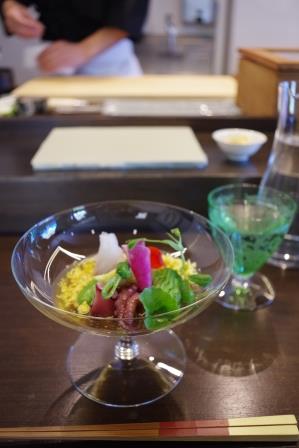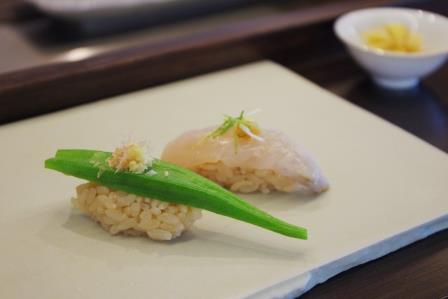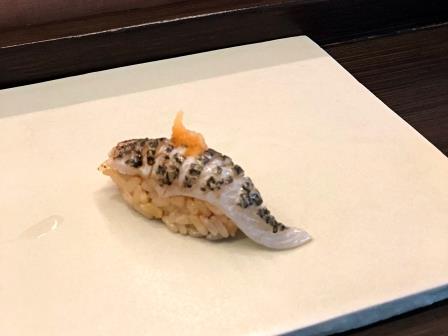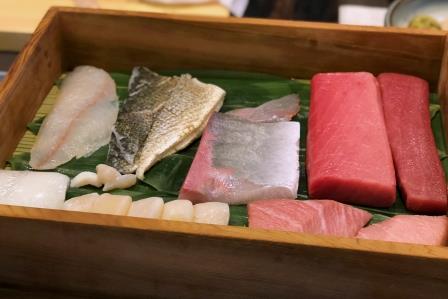Hashtag "#sake" returned 294 results.

By Kosuke Kuji
The International Wine Challenge (IWC) started the Japanese Sake Division since 2007, with one “Champion Sake” selected every year from around the world. The first champion sake “Kikuhime” from Ishikawa prefecture to the 2017 winner “Nanbu Bijin” all gathered at the high-end casino hotel Winn Palace in Macao.
Also, the Chief Operation Officer of the IWC sake judge & Wine Master Kenichi Ohashi conducted a study training session called the Japanese Sake Master Class and sampling event while a special dinner was served pairing high-end French and Japanese cuisine with the generations of Champion Sake selections. We breweries recognized for our winning Champion Sake attended wearing kimonos to introduce our traditional Japanese sake to affluent attendees from around the world gathered in Macao.
Since there was no previous opportunity for breweries that produced generations of Champion Sake to gather in one place, I’d like to take this opportunity to introduce the appeal of Champion Sake – the crown jewel of Japanese sake brands - to the world.
The world awaits Japanese sake! To reach an era where people around the world will toast to Japanese sake, I’d like to take on this mission as one brewery recognized with the honor of having produced Champion Sake, to actively introduce Champion Sake throughout Japan and to the world!
歴代IWCチャンピオンサケ蔵元試飲会inマカオ
インターナショナルワインチャレンジ(IWC)は2007年から日本酒部門が開催され、毎年世界一の称号である「チャンピオンサケ」が生まれています。初代チャンピオンサケは石川県の「菊姫」さんで、2007年の初代チャンピオンから2017年の南部美人まで歴代のチャンピオンサケがマカオの高級カジノホテル「ウインパレス」に勢揃いしました。
そして、マスターオブワインでIWCのサケジャッジの最高責任者を務める大橋健一MW氏による日本酒マスタークラスという勉強会や、試飲会、そしてマカオの最高のフレンチや日本食と歴代チャンピオンサケを1皿ずつペアリングするスペシャルディナーなどが行われました。私達歴代チャンピオンサケの蔵元は、着物で参加して、日本の伝統文化としての日本酒をマカオに集まる世界の大富豪の方々に伝えることが出来ました。
今まで歴代チャンピオンサケの蔵元が一堂に集まる機会は無かったという事で、これをきっかけに世界中で、そして日本で、日本酒の最高峰を極めたチャンピオンサケの魅力と、日本酒を素晴らしいコンテンツとして世界に伝えて行ければと思います。
世界は日本酒を待っている!世界中で日本酒で乾杯できる時代をこれからも創って行くために、チャンピオンサケを受賞した蔵元としての使命と責任を果たしながら、日本酒を日本中に、そして世界中に伝える伝道師としても活動して行きたいと思います。

By Yuji Matsumoto
I was blessed with an opportunity to attend a lecture targeting salesmen for a wholesaler of Japanese food products in the U.S. The attendees handle various Japanese food products including sake. The theme of the lecture was not so much about the consumer’s question of “Which sake to buy,” but centered more on how to get chefs / restaurant owners, not limited to Japanese cuisine by non-Japanese restaurant owners / chefs, to purchase sake?
First, it’s important to determine what type of cuisine is served, targeting whom.
• Seafood
• Steak
• Italian
• Chinese
• Korean
• French
The beverage is narrowed down with the understanding that depending on the cuisine served, the sake to be offered will change accordingly.
Secondly, check to see the prices of popular and top-selling wines for that restaurant.
To start, it’s important to start with a price set that’s appropriate for their target audience.
Thirdly, have the staff understand it’s appropriate to serve sake in wine glasses.
Fourth, the servers discussed how to explain the characteristics of each sake brand, and how to determine the compatibility of each brand with the cuisine.
Unfortunately, sake still has not become widespread to the point that shelving them in stores will be enough to sell the brand on its own. The reality is, sake is still a product to be sampled by customers following recommendations by servers. Until now, sake was mostly consumed in Japanese restaurants. In the future, we’d like to anticipate sake sales to non-Japanese restaurants as well.
非日本食レストランへの期待
先日米国のある日本食の卸業者のセールスマンを対象に講義をする機会に恵まれた。受講者は日本酒も含めて多々ある日本食材を取り扱っている方々である。講義の内容は一般消費者の知りたい「どの酒をかったらよいか」というよりもいかに非日本人の日本食に限らないオーナー/シェフに日本酒を買ってもらえるかを中心においたものにした。
まずは、第一は対象とする店がなんの店なのかを知ること。
-シーフード系
-ステーキ系
-イタリアン系
-中国系
-韓国系
-フレンチ系
これによってオファーする酒が全く変わってくることへの理解と銘柄の絞り込みをする。
第二に、そこに置いてある売れ筋や人気のあるワインがいくらで売られているかを見る。
-要はそこの客層にあった価格のものをぶつけること
第三に、ワイングラスでも飲ませることができることを理解してもらえる。
第四に、サーバーに対してどのように商品特徴を説明させ、また食事との相性をトレーニングしていくかの方法論について講義した。
まだまだ残念ながら日本酒は米国のスーパーにおいて置けば勝手に売れる商品とはなっていない。現実は、レストランで勧められ飲んでもらう商品なのだ。いままでは日本食レストランでほとんど消費されていたのだが、今後は非日本食レストランへの販売を期待したいものだ。

By Kosuke Kuji
The Annual Japan Sake Awards announced their winners: Nambu Bijin Brewery, and Nambu Bijin Brewery – Basenkyo that simultaneously won the Gold Medal two consecutive years. The Nambu Bijin Brewery won the Gold Medal 12 times in the last 13 years, while Nambu Bijin Brewery – Basenkyo was newly awarded a refined sake production license and won 3 Gold Medals in 4 years.
I recently attended the Production Technology Research Society’s Sake Tasting Event held in Higashi-Hiroshima, attended by Brewery Masters, Master Sake Brewers, and sake production-related professionals to sample the sake entries for this national tasting event. While the necks of some of the various sake bottles were labeled with the Gold Medal mark, while others were not, all of the sake brands were high in quality, indicating the sake production technology is truly advancing nationwide.
This year was more challenging than usual in producing the Yamadanishiki. It’s been a while since sake production was this challenging, and for this reason, the Master Sake Brewers were more jovial than usual when the production season ended.
The number of submissions recognized with the Gold Award and other prizes were high overall across Iwate prefecture. As a Technical Vice Chairman, I was glad to have contributed to this achievement in what small way I could.
Breweries have since switched gears, preparing for the next sake production season. While greater production challenges than this past season may wait, we look forward to overcoming these challenges together to produce sake that our consumers will smile upon tasting. We look forward to your continued support for Nambu Bijin!!
全国新酒鑑評会「ダブル金賞」
先日発表された全国新酒鑑評会で本社蔵、馬仙峡蔵が2年連続の金賞を同時にいただきました。本社蔵は近年13年で12回の金賞、馬仙峡蔵は新規清酒製造免許をいただいて4年で3回の金賞受賞となります。
東広島で開催された製造技術研究会に行ってまいりました。全国から集まった蔵元、杜氏、製造関係者が一堂に全国鑑評会出品酒をきき酒します。酒の首には金賞のマークがあるもの、無いもの様々ですが、どのお酒もレベルが高く、本当に全国の技術が高くなっていることが実感できます。
今年は今まで以上に山田錦の扱いに苦労した年でした。これほど大変だったのは久しぶりで、その苦労の分、杜氏達の喜びも例年以上でした。
岩手県全体でも今年は金賞、入賞の率が高く、私も県の技術副委員長として少しは貢献できたのかと思っています。
気持ちを切り替えて、来期の酒造りに蔵はもう向かっています。今年以上の苦しみもあるかもしれませんが、それをみんなで乗り越えてまた飲んでいただく皆さんが笑顔になる酒造りを目指していきます。これからも南部美人をどうぞ応援よろしくお願いします!!

By Elli Sekine
“Yume Sushi”, a famous popular sushi restaurant located in the Alameda District, which is on the east side of the bay across the Bay Bridge of San Francisco, closed its doors last fall and is still being missed by many people. Yume’s owner entrusted the next phase of his dream to Chikara Ono, who now runs some hot restaurants in the East Bay such as Delage and As B-Dama, which are really on a roll. The restaurant which opened only less than half a year after the closing of Yume Sushi is “Utzutzu”, which offers new concept kaiseki cuisine. Their menu uses the word, “Okimari”, instead of “Omakase”, which exhibits the strong will of this young manager. “Utzutzu (reality in Japanese)” that succeeded “Yume (dream in Japanese)” has been filled up with customers every day despite the fact that they opened only a short time ago.
The restaurant is located on a major street, but no sigh is displayed on the street, and you need to go upstairs to enter, which gives this place a hideout-like ambience. The interior decoration has a combined theme of antique Taisho-era romantic and Showa-era modern. By removing the wall to the next room which was an office space, the sushi counter was made, and a cool royal blue- colored couch was added to create a lounge. They take only 5:30 and 8:30 reservations, and the two reservations do not overlap. Customers are to wait in the lounge, enjoying drinks until everybody in the party arrives. The drink menu contains 2 to 3 kinds of each Daiginjo, Ginjo, and Junmai sake brands, plus beer is domestic beer and two kinds of Japanese craft beer. Nicely cooled sake is served in an antique glass. The chef who serves sushi at the counter is Joji Nonaka, who has experience working at Tsukiji selling wholesale fresh seafood, and at Ichi Sushi, a popular sushi restaurant in San Francisco. He determines the contents of the menu with Chef Asuka Uchida, who is in charge of other items besides sushi.
Nonaka was making sushi side by side with Ono behind the counter of Delage, long before the opening of Utzutzu came up. Ono then decided to entrust Utzutzu to Nonaka by witnessing Ono always offering customers sushi at the best possible condition. As for Chef Uchida, she has a background of working at French restaurants, and has worked in Japan, Australia, and New York before.
Chef Uchida has worked under Ono for nearly 5 years since the B- Dama days, and her keen sense in cooking is highly trusted.
There is only one menu item, which is the $100 Okimari course. The course consists of 15 to 16 pieces of sushi, and seasonal vegetable dishes are served in-between while sushi is served. To finalize the course, temaki (hand-rolled) sushi, and miso soup, and a dessert are served. In America, a course with pre-fixed price and menu can be called “Omakase”; however in Japan, it is called “Okimari”. “Omakase” in Japan, on the other hand, means neither the price nor the contents of the course is pre-fixed. It is an ultimate choice, in which the crafty chef makes sushi, etc., depending on the customer’s preference, and serves whatever the good ingredients they have for the day.
Nonaka says that he would also like to offer an “Omakase” menu in the future. At Utzutzu, they are particular about serving authentic Japanese style sushi. The fish is directly shipped mainly from Tsukiji and Kyushu, and for nigiri, they are particular about bringing out each fish’s natural flavor, rather than accentuating the taste with unique sauces or toppings. Depending on the ingredients, some preparation is involved such as light-salting or konbu-jime (kelp-sandwiching), but it is done to remove excess water or unwanted taste rather than accentuating the taste of the ingredient.
During my visit, black porgy konbu-jime was served first, followed by fire-grilled skin of the same fish. Excess water was removed from the tender meat by konbu-jime treatment, and the fish was light-tasting, but was full of umami.
Fatty skin adds flavor, and its texture becomes so tender, which melts in your mouth. The same fish can be enjoyed in totally different ways depending on the parts. The course always includes about 2 pieces of vegetable sushi. It is because they want the course to have variations with a seasonal flare that is uniquely California.
Different blends of soy sauces are used to accentuate light-tasting ingredients and rich-tasting ingredients. Another example of particularity they exhibit is that raw wasabi directly shipped from Japan is grated in front of customers.
Rich-colored vinegared rice is made with mildly sweet red vinegar. Nonaka says that he would like to keep the old sushi traditions, but at the same time, bring any good things in to grow further. He is assertive about taking any interesting ingredients in. For example, a vegetable called seabean, which grows by the sea is combined with fatty tuna for the course’s last item, a hand-roll, taking advantage of its natural saltiness and crunchy texture. It’s the Nonaka version of the standard hand-roll, “Toro-Taku”, arranged his way.
For the dishes other than sushi, they use vegetables procured from the local farmer’s markets, which are cooked in robust flavor, which also matches Japanese sake well.
French cuisine-influenced good sense is shown in the techniques and presentations by the chef of that background. For instance, the base of octopus in vinegar sauce has certainly a Japanese dashi-based taste, but it is presented so gorgeously in a cocktail glass, which looks like a modern French dish. Their desserts also taste so good, and are beyond the level of a sushi place, and their beautiful appearance will surely satisfy customers.
This restaurant is full of customers every day. Foodies come from not only the local Alameda District, but also San Francisco, and fill this restaurant. While the high-end Omakase sushi boom seems to have settled, there are more customers now, who understand sushi culture well, and this must be the reason for the popularity of this place.
Both Chef Nonaka and Chef Uchida hope to evolve the Japan-like sushi style further, while conveying it to American people. I would like to keep close eyes on Utzutzu’s future development.
限定7席の隠れ家で味わう築地仕込みの本格寿司
サンフランシスコからベイブリッジを渡った東側の湾、アラメダ地区に寿司の名店として人気を博していた「Yume Sushi」が昨年秋、周囲に惜しまれつつ閉店した。Yumeのオーナーがその夢の続きを託した人物が、今イーストベイでノリに乗っている人気店、DelageやAs B-damaの経営者である小野力氏だ。クローズからたった半年余りでオープンしたのが、新しいコンセプトの寿司懐石を提案する「Utzutzu」だ。メニューには「おまかせ」ならぬ「おきまり」と明記し、若き経営者の本気度を感じさせられる。「夢 Yume」の後を引き継いた「現(うつつ) Utzutzu」はまだ開店したばかりにも関わらず連日満席の人気ぶりだ。
店はメインストリートに位置するが、看板もなく階段を上がった二階にある隠れ家的存在だ。内装は大正ロマン/昭和モダンを取り入れたアンティークなイメージで統一されている。元事務所スペースとの壁を取り壊し、寿司カウンターに加え、鮮やかなロイヤルブルーのソファーを配したラウンジを作った。予約は5時半と8時半の完全入れ替え制。客は全員が揃うのを待つ間、このラウンジでドリンクを楽しむ。ドリンクは日本酒が大吟醸、吟醸、純米酒が2〜3種ずつ、ビールはローカルと日本のクラフトビール2種。適温に冷やされた酒はアンティークのグラスで提供される。カウンターで寿司を握るのは、築地での鮮魚卸やサンフランシスコの人気寿司店ICHI Sushiでの経験もある野中城治シェフ。メニュー内容は寿司以外の料理を担当する内田明日香シェフと相談して決めている。野中氏はUtzutzu開店の話が出る以前からDelageで小野氏と並びカウンターで寿司を握っていた。小野氏は常に最高の状態で客に寿司を提供しようとする野中氏を見て、Utzutzuを任せようと決めたという。一方の内田シェフはフレンチレストラン出身で、日本、オーストラリア、ニューヨークでの経験を経て現在がある。小野氏の元ではB-dama時代から5年近く仕事をし、その料理センスには全幅の信頼がある。
メニューは$100のおきまり1コースのみ。寿司が15〜16貫、合間にキッチンからの季節の野菜料理があり、しめの手巻きすしと味噌汁、デザートと続く。アメリカでは価格とメニューの決まったコースは「おまかせ」で通るが、日本ではこのスタイルは「おきまり」と呼ばれる。一方の「おまかせ」は価格もメニュー内容も決まりはなく、職人は客の好みやその日の良いネタからそれぞれの客に合わせて寿司を出す究極のセレクションだ。野中氏は将来的に「おまかせ」も提供して行きたいと語る。Utzutzuでのこだわりは日本的な寿司。魚は主に築地や九州からの直送で、握りには変わりソースやトッピングで味を乗せるのではなく、魚の味を引き出すことにこだわる。ネタによっては軽く塩や昆布で〆るなどの手をかけるが、これは味をのせるためというよりも、余分な水分や雑味を取り除くための仕事だ。訪店時には最初に黒鯛の昆布締めが出され、続いて黒鯛の皮の部分の炙りをいただいた。淡白で柔らかい身は昆布で締めることで余分な水分が抜け、さっぱりとしつつ旨味が広がる。脂ののった皮には香ばしさが加わりとろける口当たりになる。同じ魚でも部位で全く違う味わいを楽しめる。握りの中には必ず2貫程度野菜の握りもある。カリフォルニアならではの季節感を出し、コースに変化を持たせるためだ。淡白なネタと味の濃いネタでは仕上げ醤油の配合も変えている。日本から直送の生ワサビを客の前でおろして使うのもこだわりだ。
濃い色の酢飯はまろやかな甘みのある赤酢(粕酢)を使用している。野中氏は寿司の伝統にもこだわりつつ、良いものは取り入れ成長して行きたいと語る。食材でも面白いものがあれば積極的にとり入れる。例えばシービーンズという海岸で育つ野菜は天然の塩気とシャキシャキとした食感を生かし、最後の手巻きでトロと合わせる。手巻きの定番、「トロタク」を野中流にアレンジした形だ。
寿司以外の料理は地元のファーマーズマーケットなどから仕入れた野菜を使い、日本酒にも合うしっかりとした味付けになっている。テクニックや盛り付けにはフレンチ出身シェフならではセンスも生かされている。例えば蛸の酢の物のベースはしっかりと和の出汁の聞いた味わいだが、カクテルグラスへの盛り付けはモダンフレンチを思わせる華やかさだ。デザートも寿司屋の域を超えたパティスリーレベルの美味しさ、美しさで客を満足させる。
店はすでに連日フルハウス。地元アラメダのみならず、サンフランシスコからのフーディーな客でいっぱいだ。ハイエンドおまかせ寿司ブームは一段落したとはいえ、数年前よりも寿司に理解のある客が増えたからこその人気ではないだろうか。より日本らしい寿司スタイルをアメリカ人にも伝えつつ進化させたいとする野中氏と内田氏。Utzutzuの展開をこれからも注視していきたい。
Utzutzu
1428 Park St, Alameda, CA 94501
Tel: (510) 263-8122
Business Hours Tue-Sun 5:30-,8:30 - (replacement system)
Monday closed
Reservation: Through Resy

Experience and knowledge are indispensable for sake tasting, but doing many tastings absent-mindedly does not help.
Many tend to think that a person must have an excellent sense of judging taste (to have people think that way is very flattering), but that isn’t necessarily so. Also, those who wish to become a sake sommelier seem to think that one must keep on trying different types of sake.
To be able to taste sake, the most importing to do is to identify and set your own tasting criteria. The criteria are not based on one’s preferences, so one must find the foundation that become the basis for judging various sake. One must have that foundation in place to be able to recognize aroma, acidity, body and umami, that different types of sake have. Knowledge and information that you gather would supplement that to help correctly and fairly assess sake products.
So how can one establish that foundation for establishing your own tasting criteria? Here is the quickest and least expensive way of doing it, based on my own experience.
First, buy low-priced sake at a store. Try it every day for 15 days, even if you don’t like it or it’s simply horrible (some people may need 20 days). Do not drink it until it makes you drunk. It’s most important that you drink a certain amount every day, even if it’s just enough to fill an ochoko (tiny sake cup). Do not try other sake while you’re trying one.
Stop for two to three days to rest your liver, then do a tasting of a different sake. You will probably realize that you can profile the sake to surprising details. The differences in acidity, the body, aroma, and umami, as well as aftertaste intensity – you should be able to clearly tell those differences.
Once you have that understanding, all you need to do is study on which step of the process makes those differences. Also, deepen your understanding on raw ingredients and water, and study how to express them as well as food pairings. This way, you will become a great sake sommelier.
日本酒を利く
日本酒を利くにはもちろん経験と知識が必要となるが無意識に多数利いても意味がない。
多くの人は、利き酒師になるためには人一倍の味覚判断能力が必要(そう思っていただくことは非常に光栄なこと)なのではないかと思われがちだが、必ずしもそうではない。さらに利き酒師になりたい多くの人は種類の違う酒をとにかく試さなくてはいけないと思いこんでいると思われる。
利き酒をするにあたって一番重要なことは自分自身の味覚基準を設定、見つけることである。基準とは自分自身の好みではなく、他の酒を判定するのに必要な味覚の軸となるものを見つけることにある。その軸となる味をしっかりと持つことにより他の酒の違う香り、酸味、ボディー、旨みを感じるようになるのだ。後は知識と情報収集により、他の商品をより公平にしかも的確に評価できるようになるのである。
ではその軸を見つける方法だが、今回私自身の経験から一番手っ取り早く、しかも費用のかからない味覚判断基準の見つけ方をお教えしよう。
店頭で安い日本酒を購入し、嫌い、まずい酒でもひたすら同じ酒を15日間毎日飲むこと(人によっては20日間くらいかかる人もいるだろうが)。決して酔うまでは飲まないこと。量はお猪口一杯でもすする程度でもいいから欠かさず飲むことが必要となる。(その間、他の日本酒は飲まない方がよい)
2~3日の肝臓休憩後に違う日本酒を利いてみる。おそらく、いままでは分からなかった味が恐ろしく利けることになってるだろう。酸味の違い、ボディーの濃淡、香りの違い、旨みのレベル、後味の強弱がはっきりと分かるようになる。
それが理解できてくれば、後はそれらの違いがどこの工程、造りで影響されるのかを勉強すればいいのだ。また、原材料や水についても知識を深め、さらに表現力と料理との相性を勉強していけば立派な利き酒師となれるのである。

By Kosuke Kuji
This February, sake from ten member breweries of the Japanese Sake Export Association arrived in containers at a port in Myanmar to be sold in restaurants. To commemorate this event, a Japanese Sake Sampling Event was held with JETRO’s cooperation at a hotel in Yangon. Eight breweries participated from Japan, and two breweries exhibited their products. Sake-sampling events targeting Japanese consumers were held on the first day, and another targeting Burmese professionals in the Japanese restaurant industry was held on the second day. Many consumers participated, which brought us a feeling of relief that “we can finally provide stable supplies of Japanese sake products.”
On the third day, a meeting to study Japanese sake was held to communicate the appealing points of Japanese sake to Burmese influencers.
Our project took two years to deliver Japanese sake to Myanmar. The Japanese Sake Export Association created a pathway to distribute Japanese sake in Myanmar, where no laws pertaining to the import of Japanese sake existed previously. Our efforts opened the door for many sake breweries to expand hereafter into Myanmar, known as the last Asian frontier. With many sake breweries following suit into Myanmar, the original narrow path will gradually expand!
This year, 2018, became “the dawn of Japanese sake” for Myanmar! We cannot express our sense of accomplishment and satisfaction from witnessing this historic moment. We look forward to working even harder to deliver delicious Japanese sake to our consumers in Myanmar!
ミャンマーの「日本酒の夜明け」 その2
そして今年の2月、日本酒輸出協会加盟の蔵元10社のお酒が冷蔵コンテナでミャンマーの港に到着して、これからレストランへの販売が開始されます。それを記念して、今回もジェトロさんの協力の元、日本酒試飲商談会がヤンゴンのホテルで開催されました。日本からは8蔵が参加、2蔵はお酒の出品となり、1日目は日本人向けの試飲会、そして2日目はミャンマー人日本食レストラン関係者向けの試飲会となりました。多くのお客様に参加していただき、皆さんが「やっと日本酒を安定的に提供できる」という安堵感に包まれました。
そして3日目は、ミャンマー人向けに日本酒の勉強会が開催されて、ミャンマーのインフルエンサーの皆さんに日本酒の素晴らしさを伝えました。
2年かけて進めてきたこのミャンマーへの日本酒を入れるプロジェクト。まさに法律も無い状態の大草原に1本の獣道を私達日本酒輸出協会がつくり続けてきました。1本の細い獣道ですが、これからたくさんの蔵元がアジア最後のフロンティアと呼ばれるミャンマーに入ってくることが可能になりました。多くの蔵が続いてくることで、獣道は舗装道路になり、そして将来は高速道路になります。
2018年、ミャンマーの「日本酒の夜明け」となりました!!歴史的な場面に立つことが出来てこれ以上の達成感と幸福感はありません。ミャンマーの皆さんにおいしい日本酒をしっかりとこれからも飲んでいただけるように、さらに頑張っていきます!!

By Yuji Matsumoto
I often see breweries and wholesale dealers recommending their sake to local American diners at sampling events, saying, “This sake goes with any food,” “We use 100% Yamadanishiki rice,” “This is Junmai Daiginjo,” and “This is a traditional kimoto sake,” etc. However, most people (including myself) don’t understand what those industry jargon means. In other words, “So what are the flavors of sake, and what foods does the sake go well with?” is my question.
While sake fully utilizes processing techniques to create differences in flavor as a product, wine is largely influenced by the flavor of the grapes themselves, more of an agricultural product. In other words, the flavor of sake can be designed to some extent and adjusted (through the selection of rice, grade of rice polishing, fermentation, temperature, storage method, etc.), while wine is largely dependent on the quality of grapes harvested that year. Of course, wine can be blended and processed to some extent through fermentation temperature, storage method, etc., but sake does not reflect the “flavor” of the original ingredient like wine does. If that’s the case, the best and quickest way to understand sake and to communicate the flavor is to understand the brewery’s objective for the particular brand (design objective). However, unfortunately many breweries (including importers) don’t understand this. Even if they understand, the breweries don’t know how to adequately express the sake flavors.
Making delicious sake, made in traditional ways, keeping to tradition, goes with any cuisine, utilizing Yamadanishiki, the king of sake rice; a gold-medal winner of xxx collection, sake YY made from rice produced in abundant nature, Junmai Daiginjo, etc., and various other advertising blurbs are used to recommend sake, while none of the words communicate the anticipated flavors, the flavors of homemade sake, nor describes what sake produced in abundant nature tastes like. Isn’t it most important to accurately communicate to consumers the brewery’s “philosophy and objective towards the brand’s flavor?” For example, the brewery’s benefits of hard water should be capitalized upon, and the use of XX rice to pursue the ultimate compatibility with meat dishes, how the sake is created using rice YYY to create a uniqueness that won’t be defeated by wine or shochu, etc., to suggest designing sake that proposes a more narrowed-down qualities to customers.
目的ある酒造りへ
よく試飲会で蔵元や問屋業者が自社の酒に対して「どんな料理にも合いますよ」とか「山田錦を100%使ってます」、「純米大吟醸です」、「伝統的なキモト造りです」などと言ってアメリカ人に勧めているのを見る。しかし、多くの人(私自身も)はその意味が分からない。要するに「だから、どういう味がして何に合うのか」を知りたいのだ。
日本酒は加工技術を駆使させて味の変化を出すことができる製品に対してワインはブドウそのものの味が大きく左右する、いわゆる農業製品に近いのである。言い方を変えれば、日本酒はある程度味の設計を造り(米の選択、精米歩合、醗酵、温度、貯蔵方法など)によって調整できるできるのに対して、ワインはその年のブドウ品質でほとんど決定するのである。もちろんブレンドしたり、醗酵温度や貯蔵方法などのある程度の加工方法を取り入れるが、日本酒はワインほど原料が“味”に反映されない。さて、それならば日本酒を知る、伝えるのに一番の方法は、蔵のその酒に対しての方針(設計目的)を知ることが分かれば話は早いのである。しかし、残念ながら多くの蔵元(輸入業者も含め)はこれを理解していない。理解はしていてもどのように表現していいのか分からないでいる。美味しい酒造り、昔ながらの手作り、伝統を守っている、どんな食事にも合う、酒米の王様山田錦使用、xxxコレクションで金賞、自然豊かな大地で育まれたYY酒、純米大吟醸造りなどなど色々な宣伝文句をみるが、はっきり言って消費者の立場からしたら味の予想や選択する際の基準には全くなっていない。美味しい酒ってどんな味がするのか、手作りの酒ってどんな味がするのか、自然豊かな大地で造った酒ってどんな味がするのか、ということである。蔵の本来目指している“味の理念や目的”を明確に消費者に訴えることがもっと必要であるのではないであろうか。たとえば、当蔵の水質(硬水)のメリットを生かし、肉料理との究極な相性を追及するために米はXX、造りはYYY、ワインや焼酎にも負けない個性を演出した、などもっと絞り込んだ消費者への提言と酒設計造りが必要なのではないだろうか。

By Kosuke Kuji
Japanese sake was officially imported into Myanmar for the first time in February 2018. Official export of Japanese sake to Myanmar that the Sake Export Association (of which I’m also a member) had long worked towards finally became a reality. There was no law up to this point to allow the import of Japanese sake into Myanmar, yet Japanese restaurants in Myanmar expressed a desire to offer Japanese sake to their diners. Therefore, I carried a few bottles with me as carry-on luggage when boarding a plane to personally deliver sake to the restaurants I visited. However, since there was no way to stabilize the supply of Japanese sake to these restaurants, and due to the limited quantity of sake bottles I could carry each time, my efforts could not lead to sales.
During the first sake-sampling event in Myanmar, jointly hosted by the Sake Export Association and JETRO last May, many Japanese restaurants expressed an overwhelming desire to “officially import Japanese sake into Myanmar as soon as possible.” Upon receiving this request, thanks to efforts by JETRO and local influential support, our corporate partner was granted the first Japanese Sake Import License to Myanmar.
Myanmar is a hot, tropical nation where Japanese sake cannot be stored and managed at room temperature. Therefore, not only is Japanese sake transported in a refrigerated container from Japan to Myanmar, support was received from a local Japanese-affiliated company, Premium Distribution Co., Ltd., to thoroughly and successfully manage the sake refrigerated from storage to distribution.
Also, the Japanese Sake Import License to Myanmar is not a limited license, but an official license with the least restrictions, enabling a stable supply of Japanese sake in both ‘quality’ and ‘quantity’ to Myanmar. To be continued.
ミャンマーの「日本酒の夜明け」 その1
2018年2月、ミャンマーに初めて日本酒が正式輸入されました。私も加盟する日本酒輸出協会が2年前から取り組んできたミャンマーへの日本酒の正式な輸出が実現しました。今までミャンマーは日本酒を輸入するための法律がありませんでした。しかし、それでもミャンマーの日本食レストランは日本酒を置きたいとのことでしたので、私は日本から手荷物として機内へ持ち込んで店に提供していました。でもそれでは安定的に日本酒を提供する事が出来ませんし、持ってくるお酒にも限界があるので、商売に繋げられません。
昨年5月に日本酒輸出協会とジェトロが主催したミャンマー初の試飲会があり、多くの日本食レストランから「早く日本酒を正式にミャンマーに輸入してほしい」という意見が圧倒的にありました。その意見を受けて、ジェトロや現地の有力者のおかげで、この度、ミャンマーへの日本酒輸入免許第1号が私達のパートナーの会社におりました。
ミャンマーは熱帯の国ですので、とても暑いです。そんな国で常温で日本酒を管理することは絶対避けなければいけないという事から、日本国内からミャンマーへの冷蔵コンテナでの輸送はもちろんですが、現地でも日系企業のプレミアム双日ロジスティックスさんの力を借りて、保存から流通まで全て冷蔵での管理を徹底する事に成功しました。
さらに日本酒輸入免許も限定的な免許ではなく、量の制限が無い正規の免許での輸入が出来ることになり、まさに「品質」「量」とも安定的にミャンマーでの供給が可能になりました。

By Yuji Matsumoto
This is a trend I’ve recently noticed in the last two to three years, but I’ve noticed a widening division between the winning vs. losing brands of sake and shochu.
The reason is as follows:
- While the economy is slowly recovering, customers are still reluctant to loosen their purse strings
- The selling products vs. those that don’t are clear at the storefront
- At restaurants, labor costs (next year, the minimum wage will increase), food ingredients, and especially variable costs for fish and seafood, and fixed rental fees are increasing while the cash flow is tight.
Especially on site, because the retention time directly influences the cash flow, future tasks includes how to increase merchandise turnover.
While there is no problem as long as the merchandise is turning over, it’s likely that restaurants are considering that perhaps, it’s better to rotate cheap Japanese sake (if not, it’s a dangerous sign) rather than having expensive Japanese sake worth 500 dollars sit in storage (with a retention period of 2~3 weeks).
What must the sake and shochu industry do in order to remain competitive “winners” in the industry?
-Are you effectively communicating and impressing the quality of your products to customers?
This is the first consideration to be made. The use of materials and verbal communication does not necessarily equate to effective understanding by customers.
For example, do you offer limited promotions?
On site, table tents and creating new menus require already limited time and manpower, with very few restaurants actually able to make such offers. Thus, help from sake manufacturers and wholesalers are greatly appreciated by onsite staff.
Also, more involvement in staff training and study sessions are helpful. To make sure your company brand won’t be one of the ‘losing’ brands, I feel it’s becoming even more important for both sake manufacturers and their wholesalers to place more effort into sales strategies.
負け組にならないために
過去2~3年からの動向ではあるが、最近さらに日本酒・焼酎業界の勝ち組と負け組みがはっきりしてくるように感じられる。
理由としては;
- 景気は若干回復はしているものの依然消費者の財布の紐はかたい
- 現場で売れ筋の商品と売れない商品がはっきりとしてきている
- レストランでは、人件費(来年はさらに最低時給があがる)、素材、特に鮮魚類の価格などの変動費、レントなどの固定費も上昇でキャッシュフローがタイトであることがあげられる。
特に現場では、在庫の滞留時間がキャッシュフローに影響するのでいかに商品回転率をあげるかが課題となってくる。
回転しているのなら問題はないが、値段がはる日本酒を500ドルも抱える(滞留期間2~3週間)より安価な日本酒を回転させ資金を寝かせないよう現場では検討しているはずだ。(していないのら危険信号だ)
では、勝ち組としてレストランにおいてもらうために酒・焼酎業界はなにをしたらよいのか?
―自社の商品の本当のよさを現場に伝え、実行してもらっているか?
が一番の検討事項である。資料や口頭で伝えていても現場で効率的に顧客に伝達しているかは別問題である。
たとえば、期間を決めたプロモーションをオファーしてもらっているか?
現場では、テーブルテントや新しいメニューを作成するのは時間やマンパワーの不足で、できる店は皆無に近い。酒会社や問屋が手助けすることが現場にとって大変ありがたいものだ。
また、従業員のトレーニングの実行、勉強会を手助けするなどいろいろとできるはずだ。自社の商品が負け組みにならないよう酒会社やそれを卸している問屋の営業努力がますます大事となってくるように感じられる。

By Kosuke Kuji
In the previous column, we introduced the background that led to the Ginjo sake-sampling event held at the United Nations (UN). To hold the Ginjo sake sampling event at the United Nations headquarters means the invited guests were not local American consumers walking down the streets of New York, but representatives from 193 nations serving as delegates to the United Nations at the United Nations headquarters in New York, where the 193 representatives gathered in one place, which aligned with the Japan Premium Sake Association’s goal to “promote Ginjo sake to the world.”
Association members faced difficulties while planning the Ginjo sake-sampling event held at the United Nations (UN). However, since the Japanese government graciously assumed the role of “joint organizer,” the arrangements were easily made as the association “organized the Ginjo sake sampling event representing Japan.” Further research revealed this Japanese sake sampling event was the “first held in the world” at the United Nations headquarters, organized by the Japan Premium Sake Association literally representing Japan to accomplish this feat.
The association was highly motivated to ensure this event was successful as each member would be wearing the uniform representing Japan, and took many hours to arrange and coordinate with the UN Side in preparation for the day of the event.
The association learned from the number of pre-registered guests that a large crowd of approximately 300 guests was expected to attend. Further, the Secretary-General of the United Nations working at the United Nations headquarters and other administrative employees also expressed interest in attending the event, thus a total of approximately 350 guests were expected to attend.
Although many of the guests from around the world had never tried Japanese sake before, the guests started to understand the appeal of Ginjo sake as the event progressed and became very lively. Although guests rarely stay at these diplomatic parties until the end, nearly 100 guests captivated by the appeal of Ginjo sake remained even after the time passed for the event to end, wanting to listen to the sake brewers speak. The guests reluctant to leave until the very end left a lasting impression with the event organizers.
As representatives of Japan, the organizers made a significant accomplishment by arranging the first Ginjo sake-sampling event at the United Nations headquarters.
「世界初!国連(UN)本部での吟醸酒の会 その4」
前回のコラムでは、国連(UN)での吟醸酒の試飲会が決まった経緯をお話しました。国連本部で試飲会をするということは、招待するお客さんはニューヨークの街を歩いているアメリカ人ということではなく、国連本部に籍を置く、世界193か国の代表団の皆さんをご招待する、ということで、アメリカでの試飲会、というのではなく、場所はたまたまアメリカニューヨークですが、国連本部という場所は世界193か国の方々が一堂に集まる場所でもあり、まさに私たち吟醸酒協会が「世界へ吟醸酒のPR」という考えと合致しました。
では実際に国連(UN)での吟醸酒の試飲会を計画していくと、難しい問題もたくさん出てきました。しかし、日本国政府が「共催」の立場をとってくれていたので、非常に動きやすく、私たちはまさに「日本を代表して酒の会をする」という立場になってきました。さらに調べていくと、国連本部内での日本酒の試飲会は「世界初」で、まさに世界初の事業を日本を代表して行う吟醸酒協会という、何とも大きなお話になってきました。
私たちは日本代表のユニフォームを着てこの事業を行うのだから、絶対に成功させなければいけない、と意気込み、準備にもとても長い時間をかけて、国連側と調整し、やっと当日を迎えることになりました。
事前の申し込みでは世界193か国の代表の皆様300名近くが来るということで、大変な人数が来ることがわかりました。さらに、国連に勤める国連事務総長はじめ、事務方の皆さんも参加したいと、ということで、350名近い参加者になりました。
最初は日本酒を飲んだことが無かった世界の方々も、途中から吟醸酒の素晴らしさを理解して、大いに盛り上がりました。通常こういった外交パーティーは会の終了時間までいる人は少ないそうですが、何と終了時間を過ぎても100人近い方々が吟醸酒の魅力に取りつかれ、蔵元に話を聞きたいと、最後の最後まで帰ろうとしなかったのが印象的でした。
世界初の国連(UN)での吟醸酒試飲会、日本の代表として素晴らしい成果をあげることが出来ました。
- If you are a bloguru member, please login.
Login
- If you are not a bloguru member, you may request a free account here:
Request Account











